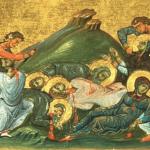I have just read a very good book that throws major new light on the history of religion(s), the making of Scripture, and the relationship between Christianity and Islam. It has substantially changed my mind on points on which I have long held quite different views.
The book is Stephen J. Shoemaker, Creating the Qur’an: A Historical-Critical Study (University of California Press, 2022). Among other things, Shoemaker is a leading scholar of the apocryphal and alternative gospels of the Virgin Mary, which is highly relevant to the present book because ideas from those Christian writings appear conspicuously in the Quran. I used his work extensively in my own book The Many Faces of Christ: The Thousand-Year Story of the Survival and Influence of the Lost Gospels (Basic Books, 2015). Through the years, I have often touched on those Christian resonances in the Quran, arguing for example that the famous Sura 97, al-Qadr, “The Night of Power” originated in a Christmas liturgy or hymn, or that the Quran directly quotes the Epistle of James. And there are plenty of other examples.
Like most people, I have explained these parallels or borrowings by assuming that Muhammad and his contemporaries had extensive access to alternative Christian traditions, which must have been freely available in his day, roughly the 620s. (Jewish ideas were also widely available, and influential). Those other traditions then informed the making of the Quran, which (I assumed) must have been substantially complete by the time of Muhammad’s death in 632. I also attach a lot of weight to the verses in Sura 5, al-Ma’idah (82-84), in which God declares that
the nearest in affection towards the believers are those who say, “We are Christians.” That is because among them are priests and monks, and they are not arrogant. And when they hear what was revealed to the Messenger, you see their eyes overflowing with tears, as they recognize the truth in it. They say, “Our Lord, we have believed, so count us among the witnesses. And why should we not believe in God, and in the truth that has come to us, and hope that our Lord will include us among the righteous people?”
So when they accepted Islam, those converted priests and monks presumably brought a lot of texts and treasures to the new faith, and these were duly translated and absorbed into the Quran. Obviously there was later editing and selection before the text as we have it, but basically that was the story.
Shoemaker makes nonsense of that approach, both in terms of place and time. Here is the description of the book:
Creating the Qur’an presents the first systematic historical-critical study of the Qur’an’s origins, drawing on methods and perspectives commonly used to study other scriptural traditions. Demonstrating in detail that the Islamic tradition relates not a single attested account of the holy text’s formation, Stephen J. Shoemaker shows how the Qur’an preserves a surprisingly diverse array of memories regarding the text’s early history and its canonization. To this he adds perspectives from radiocarbon dating of manuscripts, the linguistic history of Arabic, the social and cultural history of late ancient Arabia, and the limitations of human memory and oral transmission, as well as various peculiarities of the Qur’anic text itself. Considering all the relevant data to present the most comprehensive and convincing examination of the origin and evolution of the Qur’an available, Shoemaker concludes that the canonical text of the Qur’an was most likely produced only around the turn of the eighth century.
Read that last part again:
Shoemaker concludes that the canonical text of the Qur’an was most likely produced only around the turn of the eighth century.
I scarcely know where to start in describing such a rich and well-researched book, but here are some leading points. First, the Christian resonances and memories in the Quran are not just incidental. Rather, they assume an audience totally familiar with Christianity as it existed in Late Antiquity, with its alternative scriptural traditions. Second, and no less important, there is essentially zero evidence for any Christian presence whatever in the central Hijaz, the area in which Muhammad was living and working. Those Christian “priests and monks” were just not there to become converts, certainly in nothing like the numbers suggested by that passage I quoted earlier. Could Muhammad have had contact with such ideas elsewhere, on trading trips? Sure, but to nothing like the extent demanded here. So where is this Christian world with its knowledgeable audience? And just as important, when do we find such an audience?
Furthermore, Shoemaker looks at the landscape described in the Quran, the social, economic and environmental landscape, and shows how totally different it was from anything like the Central Hijaz. To take an obvious point, it assumes the presence of fishermen and seagoing ships. On the other hand, the picture exactly fits more fertile regions to the north, in Syria/Palestine, and/or Mesopotamia.
I am brutally summarizing Shoemaker’s argument here, but what he argues is that Muhammad existed in the 620s, and preached a message very much like what we know from conventional history. But the Quran in anything like the form we know it was mainly written in the world of Syria/Palestine/Mesopotamia as it existed around the year 700, long after the Arab Muslims had conquered and occupied the region. Or to quote the words of a very much later scholar, Al-Suyūṭī, “The Qur’an was revealed in three places: Mecca, Medina, and Syria.” It is in the late seventh century, presumably, when we find all those Christian clergy and monks accepting Islam.
As I say, I am only scratching the surface of the book, but here is an example that I find compelling. In its Sura 19:22–28, the Quran
gives a highly compressed account of the birth of Jesus that depends on a distinctive combination of Christian Nativity traditions that is uniquely found—outside the Qur’an—only in the liturgical practices of a particular Marian shrine just outside Jerusalem, the Kathisma church. In the vast world of late ancient Christianity, it is only at this church that we find combined the two early Christian traditions that appear in the Qur’an’s account of the Nativity: Christ’s birth in a remote location (rather than in Bethlehem) and Mary’s refreshment by a miraculous palm tree and spring. For good measure, one must add, the liturgical traditions of this same shrine also explicitly name Mary as the sister of Aaron, just as in the Qur’an’s Nativity account, at last providing a clear solution to this “well-known puzzle” of the Qur’an. The correspondence between this Qur’anic passage and the traditions and liturgical practices of the Kathisma church is simply too close to be mere coincidence: clearly the Qur’an knows, and expects its audience to know, this particular configuration of Christian Nativity traditions.
That is not just “drawing generally from Christian ideas,” that is taking directly from the practices of one specific monastery. This example is very convincing, and the book offers much more in the same vein.
Assuming that every part of Shoemaker’s argument is correct, this in no sense invalidates the faith of Islam, or even the value of the Quran, any more than Higher Criticism of the Bible destroys or undermines the Christian faith. But like the Biblical example, it demands real consideration of how we view the scripture. From a Christian perspective, we can see how reading the Quran also gives us a remarkable insight into the thought world of the Eastern Christianity of that era. If Shoemaker is correct, we can use the Quranic text to reconstruct that Syrian/Palestinian Christian world of Late Antiquity in some detail, and more fully understand the range and diversity of its literary resources.
That late seventh century context is multiply striking. As I have mentioned, my forthcoming book is on the iconoclasm controversy in the Byzantine world. This officially began in the 720s, and it is commonly believed that it was at least in part a response to the rigid Islamic piety reflected in that faith’s stern prohibition of images. The emperor responsible for the new policy, Leo III, was from the border region of Commagene. But if Shoemaker is right, then Leo and his contemporaries must have been very keenly aware of the religious tumult in neighboring Syria at the turn of the century, with such a fluid and dynamic relationship between the faiths.
On a related topic, I have suggested elsewhere that among the texts and writings that converted Christian clergy brought over to Islam were some key apocalyptic works with a vehemently anti-Jewish tone, which duly found their way into the Islamic hadith. If we assume that those clerical conversions are under way at the end of the seventh century, that fits the chronology of those works very well. There is a great deal to absorb here.
Read Shoemaker’s book and judge for yourself. Amazingly, the whole text is free as a pdf.














